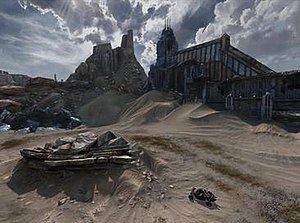Id Tech 5

An early screenshot of Rage
|
|
| Original author(s) | id Software |
|---|---|
| Initial release | October 4, 2011 |
| Written in | C++, AMPL, Clipper, Python (AI) |
| Operating system | Microsoft Windows, OS X, PlayStation 3, PlayStation 4, Xbox 360, Xbox One |
| Type | Game engine |
| License | Proprietary |
| Website | idsoftware |
id Tech 5 is a proprietary game engine released by id Software. It follows its predecessors, id Tech 1, 2, 3 and 4, all of which have subsequently been published under the GNU General Public License. It was seen as a major advancement over id Tech 4. The engine was first demonstrated at the WWDC 2007 by John D. Carmack on an eight-core computer; however, the demo used only a single core with single-threaded OpenGL implementation running on a 512 MB 7000 class Quadro video card. id Tech 5 was first used in the video game Rage, followed by Wolfenstein: The New Order, The Evil Within and Wolfenstein: The Old Blood.
The initial demonstration of the engine featured 20 GB of texture data (using a more advanced MegaTexture approach called Virtual Texturing, which supports textures with resolutions up to 128,000 × 128,000 pixels), and a completely dynamic and changeable world. This technique allows the engine to automatically stream textures into memory as needed, meaning that developers need not concern themselves with memory restraints or texture limits. This has the advantage of simplifying the creation of content, by eliminating the need to adapt content for different platforms. The engine automatically optimizes resources for cross-platform development, making it possible to render the same models on different platforms, while creating them for only one platform, further simplifying cross-platform development.
One of the visually evident features the renderer included is a penumbra in the shadowing (soft edges), by using shadow maps. In contrast, id Tech 4, which featured volume-based shadows, had very sharply defined shadows. Numerous other advanced graphical effects such as various materials for lighting, high dynamic range rendering-centric effects, bloom, crepuscular rays (volumetric lighting), radiosity, soft particles, pixel shader effects, alpha to coverage, post processing, Screen Space Reflection, dynamic water surfaces, procedural animation, cloth simulation, depth of field, and motion blur, are contained. Multi-threaded processing on the CPU is done for many of its tasks, including rendering, game logic, AI, physics, and sound processing.
...
Wikipedia
